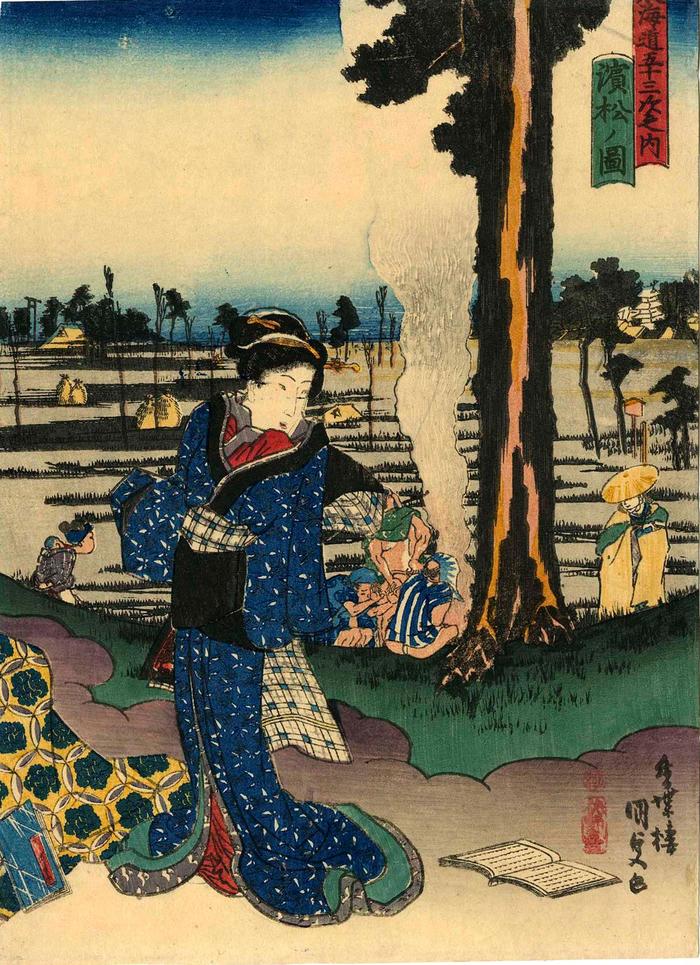Utagawa Kunisada (歌川国貞) / Toyokuni III (三代豊国) (artist 1786 – 01/12/1865)
View of Hamamatsu (Hamamatsu no zu: 浜松ノ図) from the series Fifty-three Stations of the Tōkaidō Road (Tōkaidō gojūsan tsugi no uchi: 東海道五十三次之内)
ca 1838
7 in x 9.75 in (Overall dimensions) Japanese woodblock print
Signed: Kōchōrō Kunisada ga (香蝶楼国貞画)
Publisher: Sanoya Kihei
Censor's seal: kiwame
Museum of Fine Arts, Boston
National Diet Library
Spencer Museum of Art
Museum of Fine Arts, Boston - Hiroshige's version
Museum für angewandte Kunst, Vienna
Ishikawa Prefectural Museum of Art - they date their copy to 1836
Bryn Mawr
Honolulu Museum of Art - one of three copies - this one dated to ca. 1836
Google map - Hamamatsu
Hokkaido Museum of Art
Bayerische Staatsbibliothek, München
Fujisawa Ukiyo-e Museum
Victoria and Albert Museum
Nelson-Atkins Museum of Art This is print number 30 in this series. The Museum für angewandte Kunst in Vienna curatorial files say: "In the depiction, Kunisada again sticks to Hiroshige's original, but moves the woman with the child on her back from the right side (in the case of Hiroshige) to the left side of the sheet, which suits the composition with the woman in the foreground. The woman is wearing a blue kimono decorated with butterflies with a two-tone obi (belt), which is black on one side and shows a green-white-blue grid pattern on the other side. Next to her a kotatsu (small stove with a blanket over it to warm the feet in winter) and two books, which she has probably just read."
[It should be noted that in a totally different series of Tōkaidō prints there is one for Hamamatsu designed by Kuniyoshi in which there is fan cartouche at the top with an inscription printed over a light colored ground decorated with blue butterflies. Perhaps this is tangentially related to the the butterflies which populate the design of the fabric of the standing woman seen in the foreground of this print in the Lyon Collection.]
Kunisada's chūban Bijin Tokaido (東海道美人) series was first published around 1833, after Hiroshige's famous series was underway but not yet complete.
Gian Carlo Calza in his description in Hiroshige: The Master of Nature of the original Hiroshige print re-imagined in this scene said: "It is the middle of winter and some half-naked farmers or porters have gathered around a fire at the base of a large Japanese cedar to warm themselves. The dense smoke is rising parallel to the tree trunk. A passing wayfarer turns to look at them and a young woman with a child on her back is also approaching. [The figures are all there in the Kunisada version, but the artist has moved the woman and child to the other side of the print, but still approaching the farmers.] The foreground - the figures, the tree, the smoke just above the flames - is coloured. The grass is also coloured an improbable green which perhaps had the function of emphasising that the presence of the humans restores life even to places immersed in the deepest cold and desolation. We see this just beyond them, even in the castle on the right, where the living conditions were radically different."
****
In Tokaido Landscapes: The Path from Hiroshige to Contemporary Artists, 2011, #30, p. 42, speaking of the original Hiroshige print it says in a text by Sasaki Moritoshi: "In the rice field to the right stand the famed Zazanza Pines and in the distance is Hamamatsu Castle, but Hiroshige focuses on the activity of ordinary people rather than these landmarks. As indicated in the subtitle, it is a wintry scene, but the sight of people gathering around a fire contrasts with the barren fields and creates an image of warmth."
****
Muneshige Narazaki in Masterworks of Ukiyo-e: Hiroshige, the 53 Stations of the Tōkaidō (p. 61) noted: "In the distance rises the castle that the first Tokugawa shogun, Ieyasu, ordered built and that he occupied in 1571. In the further distance, on the horizon, is a famous battlefield - called Mikatagahara - where Shingen, almost the last of the powerful Takeda family, gave battle to Ieyasu and where, some say, he was slain."
****
Illustrated in a small color reproduction in Kunisada's Tokaido: Riddles in Japanese Woodblock Prints by Andreas Marks, Hotei Publishing, 2013, page 70, T24-30.
Sanoya Kihei (佐野屋喜兵衛) (publisher)
landscape prints (fūkeiga 風景画) (genre)
beautiful woman picture (bijin-ga - 美人画) (genre)
